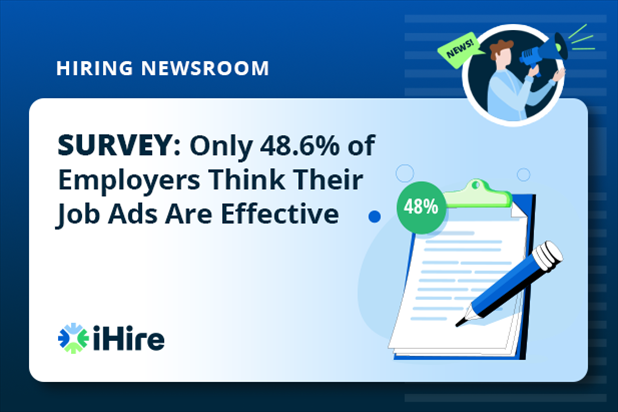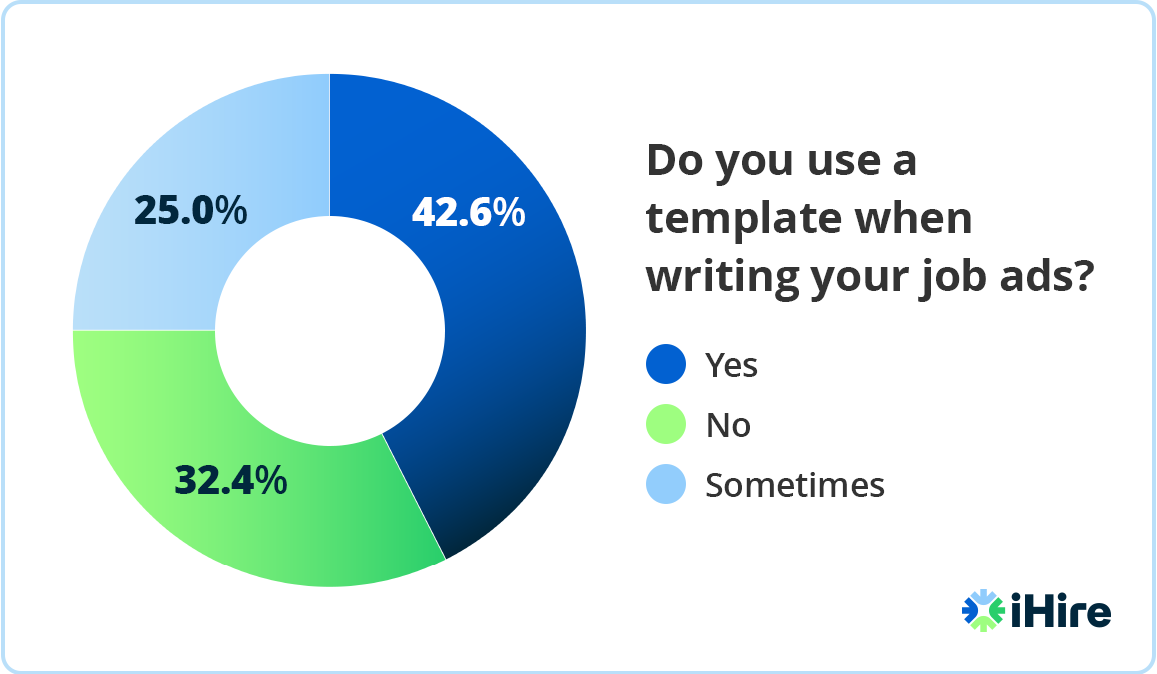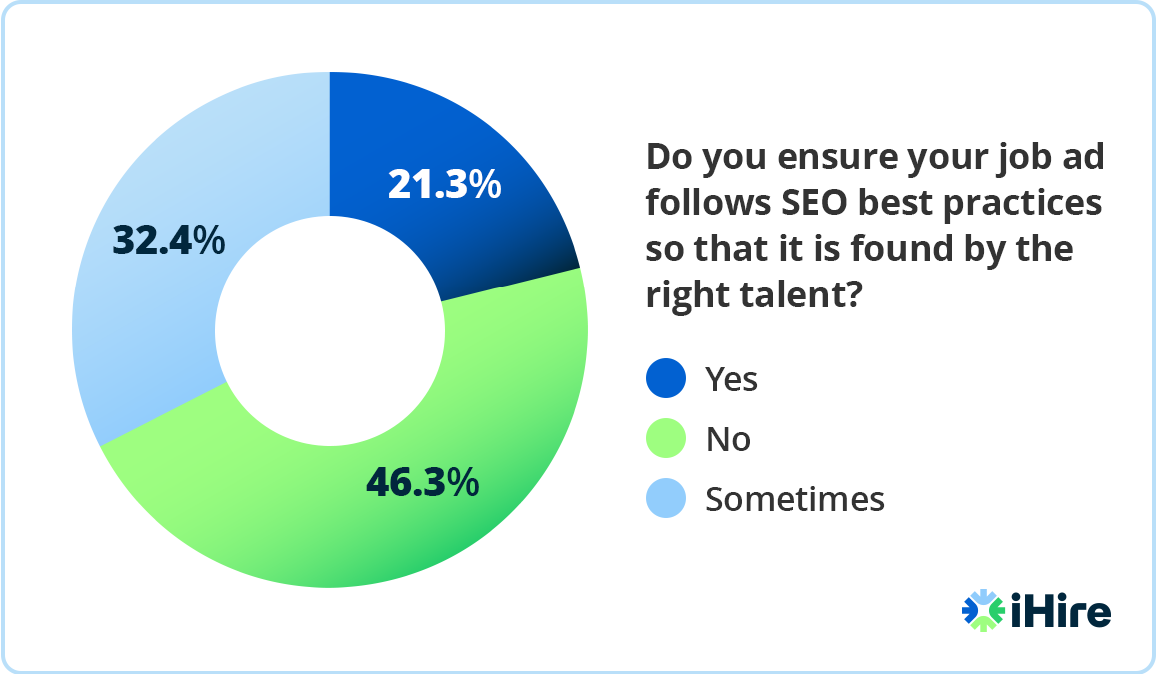- Employer Resources
- |
- Last Updated: February 07, 2024

Survey: Only 48.6% of Employers Think Their Job Ads Are Effective
Love it or hate it, writing a job ad is a key piece of the recruiting process. Without a captivating, well-crafted ad, attracting top candidates is nearly impossible. However, developing a job ad can be time-consuming, requiring the right blend of research, keywords, and persuasive language to convince candidates to click “apply.”
Hiring and HR professionals never seem to have enough hours in a day, and not everyone is a natural-born writer. So, how are today’s employers managing their job ad development process? Do they really know how to create a job posting? What challenges are they experiencing, and how effective do they believe their postings are in recruiting the right candidates?
For answers to these questions and more, we polled 216 employers from our client base who are directly involved in creating job ads for their organization. Our survey findings are as follows.
How Long Does It Take to Write a Job Ad?
First, we asked employers to estimate how long it typically takes them to write a job ad from scratch. Nearly half (47.2%) of respondents said they spend more than 30 minutes creating an ad, with 13.9% taking more than an hour. That time adds up, especially when you’re wearing multiple hats and juggling various HR and recruiting tasks.
Luckily, writing a job ad from scratch is not always necessary with the help of templates and generative artificial intelligence (AI) tools. While 67.6% of employers said they use a job posting template at least some of the time, just 10.2% use AI (like ChatGPT) to assist in creating their ads “always” or “most of the time.”

Challenges Writing a Job Ad
Finding the time to write a job ad, however, was not as big of a struggle as knowing which information to include to attract the right talent – this was the top challenge respondents cited (56.0%).
Further, 46.8% grapple with writing the ad so that it “sells” their company, and 41.7% are often unsure about which information from the job description to include in their posting.

What Information to Include in a Job Ad
Although employers were uncertain which information to include in their ad, most do comprise the most critical details: The majority of respondents said they always include candidate requirements and qualifications (78.2%), location of the job (76.4%), and benefits (63.4%).
While 56.5% always include the salary range, that percentage should be higher – as previous research has shown, listing the salary for a position increases the likelihood of a candidate applying for a job.
Job Ad Creation Best Practices
Next, we asked employers to identify the best practices they always follow when creating a new job ad. We were glad to see most employers were conscious of spelling and grammar errors – which can be a major candidate turnoff – but were surprised that less than half review their ad for potentially biased or discriminatory language (47.2%) and research and include fair and competitive salary ranges when developing their ad (46.3%).
Job Ad Effectiveness
How effective do employers think their job ads are in attracting the right candidates? Respondents were fairly confident in their postings, as 48.6% said their ads were “very effective” or “effective.” At the same time, 42.6% said their ads were just “somewhat effective,” and only 4.2% said they were “not effective.”

Despite confidence in their ads’ efficacy, half (49.1%) of employers do not track any metrics – such as view-to-apply rates, application completion rates, and total applies – to determine how well their job ads are attracting qualified candidates.

Additionally, 46.3% of employers do not ensure their ad follows SEO best practices so the right talent finds them in search results. However, the best job postings include keywords, such as the career titles, location, and required skills a candidate may search for while on the hunt for a new position.

Create Your Account Today
Advice for Writing a Job Ad
While 48.6% of employers surveyed believe their job postings are effective in attracting qualified candidates, there is always room for improvement, especially in a tight labor market when companies are vying for talent from the same pools. Based on our survey results, hiring professionals can benefit from adopting the following best practices:
- Highlight information in your ad that sells the position and your workplace to potential applicants (hence, job ad). The best job postings include the salary or salary range, benefits, company culture details, EOE statement, and anticipated hiring timeline.
- Ask your in-house (or outsourced) marketing teams for assistance crafting your ad. Marketing experts can help with wordsmithing, formatting, employer branding, and more elements that make your ad enticing. Marketers can also help you write your postings with SEO in mind, using the right keywords will ensure your ad is found by candidates in search engines and on job boards.
- Tap into generative AI tools to save time in creating templates or the ad itself, even if you are unsure how to write a job ad. AI can also proofread your work and help you research salaries and job titles to ensure your ad is fresh and relevant.
- Lean on data to determine your ad’s efficacy. Click-to-apply rates, view-to-apply rates, ad impressions, application completion rates, time-to-fill, total applies, and percentage of applicants who are qualified are a few metrics you should be tracking.
For more job ad writing tips and tricks:
- Download our eBook (with a free job posting template), “The Art of the Job Ad."
- Browse our Employer Resource Center for all things job ad development.

Originally Published: December 04, 2023








